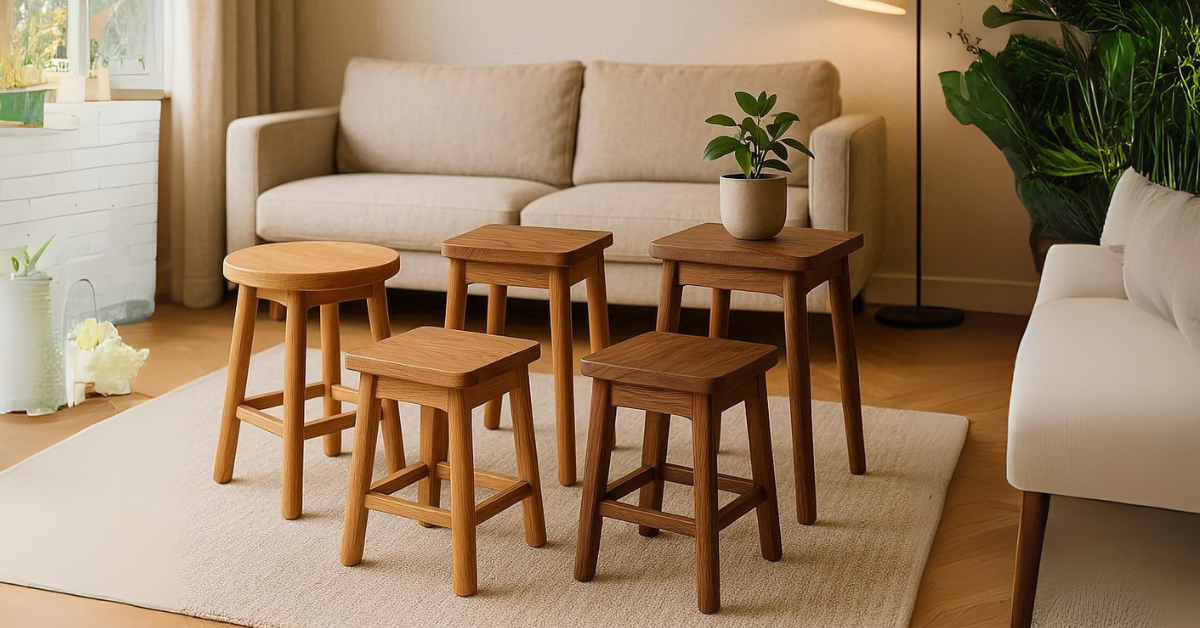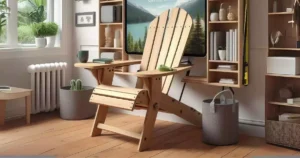Surprising fact: over 60% of homeowners say a small stool became their most-used piece of furniture after a single styling change.
You’ll find a clear promise here: this guide shows a wide range of wooden stool options to help you pick the right piece for your living room. Expect picks that work as extra seating, a portable step, or an unusual side table with a flat surface.
We cover stackable and foldable choices like the Fionia folding stool for tight space planning. You’ll also see ergonomic seat shells and height-adjustable models that improve comfort, plus notes on teak, oak, and lacquer finishes for durability.
Practical tips include what to check for stability, seat height, and surface care—like applying Tung oil annually to preserve finish and slow graying. By the end, you’ll have clear ideas to match style and function across rustic and contemporary styles.
Key Takeaways
- Explore a wide range of stool uses: seating, side table, and plant stand.
- Look for stackable or foldable models to save space.
- Choose species like teak or oak for durability and grain.
- Check seat height and stability before you buy.
- Maintain finishes with Tung oil to extend lifespan.
2025 Living Room Trends: From Rustic Roots to Contemporary Statements
This year, trends favour calm surfaces and smart mixes that make small seating feel intentional.
Natural matte finishes lead the way because they show real wood grain without glare. Earthy tones like clay, sand, and olive create a grounded palette that works with linen sofas and textured rugs.
Finish and color updates
Charred accents inspired by shou sugi ban add drama and hide scuffs when you use a seat as a side table. Two-tone treatments — dipped legs or painted bases in navy, white, or muted pastels — help your piece echo other furniture.
Material mixes you’ll love
Pairing wood with rattan or leather brings texture and contrast. Acrylic or metal frames keep silhouettes light and minimal.
- Teak stands out if you plan to move pieces near sliding doors; its oils resist moisture over time.
- Ergonomic shells and height-adjustable options let you match seat height to tables for better posture.
Tip: Choose solid joinery and good material quality so stools feel safe and last through regular use.
wooden stool designs living room rustic contemporary

Here are practical style picks that show the range you can use as seating, a side surface, or a sculptural peg in your layout.
Rustic farmhouse stools with reclaimed wood patina
Reclaimed pieces highlight grain, knots, and small dings that add character. They read warm and work well beside a sofa as a side table.
Cottagecore courtyard stools with mortise-and-tenon details
Elm courtyards use mortise-and-tenon joinery and splayed legs with stretcher bars. They’re sturdy enough for daily use and look collected over time.
Scandinavian, mid‑century, minimal, and industrial picks
Light oak and tapered legs keep things airy. Mid‑century silhouettes stay low-profile so your sightlines stay open.

Minimal block pieces act like small pedestals with a flat surface for cups or a lamp. Industrial options pair a wood top with blackened metal for contrast and easy wiping.
Portable, ergonomic, and speciality options
Stackable and foldable models save space when you don’t need them. Ergonomic seat-shells and height-adjustable pieces adapt to different tables and consoles.
Leather or rattan tops add texture, while teak versions move well between indoor and patio zones.
Placement and Purpose: Make Every Inch of Your Living Room Work

A compact seat can transform an empty nook into a purposeful area for light, plants, or a cup of coffee. Place it where you reach naturally so the piece feels intentional, not tacked on.
Side table stand-ins for lamps, books, and a cozy coffee perch
Use a low seat as a side table next to a sofa or armchair to hold a lamp, a stack of books, or your evening mug. The flat surface gives a table function without the bulk of larger tables.
Plant stands to layer height and greenery without clutter
Elevate plants at different heights to build a layered look in your interior. One seat can support a tall philodendron while another holds a trailing ivy to frame a seating area.
Accent pedestals for art, candles, and sculptural decor
Turn a compact seat into a display pedestal for art or candles to create a focal surface that invites touch. In vintage-leaning schemes, a patinaed piece softens hard floors and reads as a collected treasure.
- Keep two stools used in rotation: one as a table, one as seating, and swap roles when guests arrive.
- Choose a small-diameter top to keep circulation clear while gaining a handy surface at hand.
- Prefer a matte finish for fewer fingerprints; a sealed top resists water rings from plants or drinks.
- For rooms that open to a patio, teak holds up near doors so you can move the same piece outside and back.
Buying Smart and Caring Well: Size, Materials, and Maintenance

Begin with clear measurements so your new piece fits its role. Note seat height and the total size to avoid awkward gaps or low clearance under tables.
Seat height and ergonomics
Match a seat height of about 18 inches for sofas and chairs. For counter-adjacent perches, aim 24–26 inches.
Tip: choose a scooped seat or footrest if people will sit longer to reduce pressure behind the knees.
Best woods and durability
Pick wood by performance. Oak gives everyday strength. Teak resists moisture and works well at a patio threshold for occasional outdoor use.
Walnut and maple offer rich grain and hardness. Choose pine when you want a lighter, budget-friendly option for occasional use.
Assembly and quality
Pre-assembled pieces usually show higher quality and less wobble. Flat-pack can be fine—inspect joinery, dowels, and brackets before you buy.
Finish care and longevity
Wipe weekly with a damp cloth and apply Tung oil at least once a year. Expect a pleasant patina over time; it won’t harm the structure.
“Measure twice, buy once — fit and finish matter more than fashion.”
- Check legs for racking by twisting the top gently.
- Verify weight capacity in specs for real-world use.
🪵 Build Stunning Wooden Stools (and More) With Ease!
Why settle for generic furniture when you can create custom, professional-quality wooden stools for your living room? With Ted’s Woodworking, you’ll get:
✅ 16,000+ step-by-step woodworking plans (stools, chairs, tables & more)
✅ Detailed schematics & material lists – no guesswork, no waste
✅ Beginner-friendly & pro-level designs – perfect for any skill level
✅ Lifetime access + free monthly plans so you never run out of projects
✅ Exclusive bonuses: 150 woodworking videos, CAD viewer, guides & more
✅ 100% Risk-Free – 60 Day Money Back Guarantee
Conclusion
Finish by picking a piece that matches how you live: a compact seat can pull double duty as seating, a plant riser, or a quick side table. ,
You read an article that gave a wide range of inspiration to help you choose a wooden stool for your home. Oak, teak, and walnut each meet different needs for durability and climate adjacency.
Consider ergonomic and height-adjustable options if people sit often. Look for stackable or foldable models to save space. Vintage courtyard silhouettes add character when you want a collected look.
Measure your area, shortlist two or three options, and test them in place. Maintain finishes with Tung oil yearly so the wood stays smooth and inviting. Use these ideas to refresh your interior with flexible furniture and lasting inspiration.
FAQ
How do I choose the right seat height to pair with my sofa or coffee table?
Match the seat height to your existing furniture. Aim for stools about 16–18 inches for low sofas and 20–24 inches for higher seating or counter-style surfaces. Measuring from the floor to your sofa cushion or table surface helps you pick comfortable proportions.
Which hardwoods offer the best durability for high-traffic family areas?
Choose dense species like oak, teak, walnut, or maple for longevity. These woods resist dents and handle regular use better than softwoods like pine. Look for commercial-grade construction or solid-wood components in pieces for active households.
Can these pieces work outdoors or on a covered patio?
Some solid-wood stools with a proper seal or teak are suitable for covered outdoor use. Avoid untreated tops outdoors; opt for exterior-grade finishes or marine varnish. Bring pieces inside during extreme weather to preserve the finish and joinery.
How do I care for an oil-finished seat versus a lacquered top?
Oil finishes need periodic reapplication to maintain moisture resistance and patina—usually every 6–12 months, depending on use. Lacquered or polyurethane surfaces clean easily with a damp cloth and need less frequent maintenance, but can show scratches more readily.
Are stackable or foldable pieces sturdy enough for daily seating?
Quality stackable and foldable options can be very sturdy when built from hardwood or reinforced plywood. Check weight ratings and hardware quality. For everyday seating, prefer units with solid joinery rather than thin slats or weak hinges.
What styles pair best with a modern farmhouse or coastal interior?
For a modern farmhouse, select pieces with reclaimed patina, splayed legs, or two-tone painted bases. For coastal or boho looks, rattan-wrapped seats, light oaks, and washed finishes blend well. Keep finishes light and textures layered for a relaxed vibe.
How can I integrate a stool as a side table without damaging the surface?
Use a small protective tray or coaster to hold drinks and candles. Choosing a sealed or hard-wearing finish reduces staining risk. You can also select stools with removable tops designed to double as trays for added protection and function.
What should I look for in joinery and construction to ensure longevity?
Favor traditional joinery like mortise-and-tenon, dovetails, or reinforced dowels over simple screws if you want long-term stability. Solid-wood legs with corner blocks and cross braces add strength for family use.
Are two-tone or painted legs a durable choice for high-use furniture?
Yes, if the paint uses a durable topcoat such as polyurethane or conversion varnish. High-quality paint systems resist chipping from foot traffic better than thin, untreated paint. Consider touch-up kits from reputable brands for easy repairs.
How can I choose a stool that complements mid-century or Scandinavian furniture?
Look for clean lines, tapered legs, and minimal ornamentation. Light oaks and walnut with matte seal work well for Scandinavian simplicity or mid-century silhouettes. Keep profiles low and finishes natural to match those styles.
Is leather upholstery a practical option for living areas with children or pets?
Top-grain leather is durable and ages well, resisting spills when wiped quickly. It can show scratches from pets, so choose thicker hides and darker tones to camouflage marks. Faux options and treated leathers offer similar benefits at a lower cost.
What finishes hide wear and tear while still looking authentic?
Distressed finishes, oiled surfaces, and patina-friendly oils mask small scratches and blend wear into the aesthetic. Matte or satin seals also show fewer fingerprints and glare than high-gloss options.
Can I mix materials like metal or rattan with wood without clashing styles?
Yes. Balance is key: use repeated accents—such as metal legs echoed in lighting or hardware—to create cohesion. Pair light rattan with warm wood tones for a layered, curated look rather than a matchy-matchy set.
How much clearance should I allow when placing stools as plant stands or pedestals?
Leave at least 12–18 inches of clearance from traffic paths to prevent bumping and allow plants to be tended easily. Vary heights to create visual interest and ensure taller greenery won’t block sightlines.
What options exist for small spaces or apartment living?
Choose compact stackable or foldable pieces, nesting stools, or models that double as storage. Lightweight birch plywood or bamboo pieces are easy to move and store. Multiuse units that serve as seating, side tables, and pedestals save space.
Are adjustable-height stools worth the extra cost?
If you frequently change layouts or use pieces across different surfaces, adjustable options add versatility. They’re helpful when you need a stool to function with both a coffee table and a taller console or counter.
How do I spot sustainable or responsibly sourced options?
Look for certifications like FSC or PEFC, reclaimed or salvaged materials, and brands that publish sourcing policies. Teak from certified plantations and reclaimed elm or oak reduces environmental impact compared with unmanaged logging.
Can antique or vintage pieces be used daily, or are they better as accents?
Well-maintained antiques made from hardwood can be used daily, but inspect the joinery and finish first. Use vintage items as accents if they’re fragile or have loose joints. Professional restoration can make a historic piece more durable for regular use.
What are practical tips for preventing wobble in a four-legged seat?
Tighten all fasteners regularly and check for uneven leg lengths; small floor levellers can correct minor discrepancies. Reinforce with corner blocks or cross braces if needed, and avoid placing units on very soft surfaces that allow legs to sink.






Pingback: DIY Bathroom Wooden Stool: Waterproof Finishes & Moisture-Resistant Designs